Soundholes
Soundholes
I've always thought that soundholes, and their associated bracing, placed in their conventional spot , must rob the soundboard of it's efficiency.. Being so close to the bridge area , this part of the soundboard is very active , yet on most guitars we put a large hole in it. To my way of thinking ,there is a loss of productive soundboard area and also the cause of some weakness in that area.
There are plenty of guitars with soundholes in their upper bout , but in general, this design has never become so popular that it has become a 'standard' .. Placing the hole in the upper bout would still rob the sounding board somewhat , but to a less extent , considering that area is less active than nearer the bridge area.
Is it tradition ,that most soundholes remain in the conventional spot ?
Alan Carruth says that a soundhole placed further towards the perimeter of the soundboard tends to accentuate a bass response .I am wondering if this is due to the soundboard now having more productive area to vibrate , or is it something to do with the actual hole placement changing the dynamics of the guitar.
I must admit that most guitars I have seen with their hole placed in an alternate position, don't look particularly attractive , but that's just my opinion . Could that be another reason why the hole tends to stay where it is ?
Cheers , Craig
There are plenty of guitars with soundholes in their upper bout , but in general, this design has never become so popular that it has become a 'standard' .. Placing the hole in the upper bout would still rob the sounding board somewhat , but to a less extent , considering that area is less active than nearer the bridge area.
Is it tradition ,that most soundholes remain in the conventional spot ?
Alan Carruth says that a soundhole placed further towards the perimeter of the soundboard tends to accentuate a bass response .I am wondering if this is due to the soundboard now having more productive area to vibrate , or is it something to do with the actual hole placement changing the dynamics of the guitar.
I must admit that most guitars I have seen with their hole placed in an alternate position, don't look particularly attractive , but that's just my opinion . Could that be another reason why the hole tends to stay where it is ?
Cheers , Craig
-
jackspira
- Kauri
- Posts: 33
- Joined: Sat Oct 27, 2007 12:08 pm
- Location: Dandenongs, Melbourne
- Contact:
Hi Craig, my thoughts are that having the soundhole in the usual place, in the centre in front of the fretboard, makes a disconection between the bridge area and the neckblock area.
I assume that this disconection from a very solid part of the instrument allows for a greater amplitude of movement at the bridge but I don't really know if it does, or what characterisitic that might provide the sound
I've yet to do any experimenting ( where to find time!) but I'd like to make a guitar with the soundboard cut all the way across the top bout, so the the foward area of the lower soundboard, where the bridge is, is completely detached from the upper soundboard and neck block area.
Jack
I assume that this disconection from a very solid part of the instrument allows for a greater amplitude of movement at the bridge but I don't really know if it does, or what characterisitic that might provide the sound
I've yet to do any experimenting ( where to find time!) but I'd like to make a guitar with the soundboard cut all the way across the top bout, so the the foward area of the lower soundboard, where the bridge is, is completely detached from the upper soundboard and neck block area.
Jack
- graham mcdonald
- Blackwood
- Posts: 473
- Joined: Thu Oct 25, 2007 11:57 am
- Location: Canberra
- Contact:
As Craig suggests, having the soundhole anywhere else but the middle of the soundboard looks funny, and on guitars at least essentially stops the upper part of the soundboard doing much at all. People who have mapped the vibrational patterns of strung up guitars using holography has shown that in the important first half dozen or so resonances of the soundboards all the action is taking place below the soundhole. The higher resonances do involve the upper bouts, but the general consensus is that they don't have a great deal of influence on how well the instrument works. I don't know of anyone who has done the same work with soundholes in the upper bouts. I suspect the waist has something to do with it as well. Lots of experiments to be done, but as Jack says, it is always a matter of time.
cheers
graham
cheers
graham
Graham McDonald
http://www.mcdonaldstrings.com
http://www.mcdonaldstrings.com
- Dennis Leahy
- Blackwood
- Posts: 872
- Joined: Wed Oct 10, 2007 12:32 am
- Location: Duluth, MN, US
- Contact:
I have mostly gut feelings and conjecture to add to this, but the one and only guitar that I have completed does have it's soundhole in the upper bout.
I too think something looks "funny" about offset soundholes. I am convinced that is because I have seen 1,000,000 guitars with central soundholes and 100 with offset soundholes. I'm trying to adhere to "form follows function" in the engineering, then make it look as aesthetically pleasing as possible. And, my gut tells me that more active soundboard that is contiguous (a bigger diaphragm) will be more efficient and more adept in assisting with enhanced tone or at least in bass production. My first guitar has remarkable bass and mid bass, so I feel that I'm on the right road. That road also includes other much more radical departures from traditional Martin clone engineering (suspended structural bracing, pivoting radial bracing devoid of the X, pinless bridge coupled with a tailpiece design), so it is impossible to say exactly what role the offset soundboard plays on my guitar.
I did a set of (amateurish) Chladni patterns on my guitar, and have no idea what they really mean, but the upper bout seems pretty active.
For the next one, I'm moving the soundhole from the upper bout "bass side" to the "treble side", nested in the cutaway. I'm hoping that will give even more active, vibrating surface area to the overall top.
I was worried about making sure the soundhole was large enough to support higher frequencies. The Helmholtz frequency compared to the hole size is the opposite of what I would have guessed, so I relied on "others" to tell me that I needed a big sound hole or the bass would dominate. Now, I'm thinking that a combination of side port(s) plus the soundhole in the top will offer more freedom to size the soundboard hole smaller if I want.
Well, that's my thoughts at this point.
Dennis
I too think something looks "funny" about offset soundholes. I am convinced that is because I have seen 1,000,000 guitars with central soundholes and 100 with offset soundholes. I'm trying to adhere to "form follows function" in the engineering, then make it look as aesthetically pleasing as possible. And, my gut tells me that more active soundboard that is contiguous (a bigger diaphragm) will be more efficient and more adept in assisting with enhanced tone or at least in bass production. My first guitar has remarkable bass and mid bass, so I feel that I'm on the right road. That road also includes other much more radical departures from traditional Martin clone engineering (suspended structural bracing, pivoting radial bracing devoid of the X, pinless bridge coupled with a tailpiece design), so it is impossible to say exactly what role the offset soundboard plays on my guitar.
I did a set of (amateurish) Chladni patterns on my guitar, and have no idea what they really mean, but the upper bout seems pretty active.
For the next one, I'm moving the soundhole from the upper bout "bass side" to the "treble side", nested in the cutaway. I'm hoping that will give even more active, vibrating surface area to the overall top.
I was worried about making sure the soundhole was large enough to support higher frequencies. The Helmholtz frequency compared to the hole size is the opposite of what I would have guessed, so I relied on "others" to tell me that I needed a big sound hole or the bass would dominate. Now, I'm thinking that a combination of side port(s) plus the soundhole in the top will offer more freedom to size the soundboard hole smaller if I want.
Well, that's my thoughts at this point.
Dennis
Another damn Yank!
- graham mcdonald
- Blackwood
- Posts: 473
- Joined: Thu Oct 25, 2007 11:57 am
- Location: Canberra
- Contact:
Have a look at http://www.astro.cf.ac.uk/groups/acouco ... y.html#top
which shows the body and soundboard resonance of a classic. Although the bottom row of photos shows stuff going on in the upper bout, that is a frequencies that will have effect on the tonal quality, but not whether the instrument really works or not. That is determined by the first 5-6 resonace
cheers
graham
which shows the body and soundboard resonance of a classic. Although the bottom row of photos shows stuff going on in the upper bout, that is a frequencies that will have effect on the tonal quality, but not whether the instrument really works or not. That is determined by the first 5-6 resonace
cheers
graham
Graham McDonald
http://www.mcdonaldstrings.com
http://www.mcdonaldstrings.com
-
jackspira
- Kauri
- Posts: 33
- Joined: Sat Oct 27, 2007 12:08 pm
- Location: Dandenongs, Melbourne
- Contact:
Thanks graham, its amazing how regular and symetrical the patterns are.
I got some more conjecture, and that is that the position of the soundhole must also effect the standing waves in the air inside the box. Presumably wherever the air inside the box is open to atmosphere makes a boundary to its vibrating length ( if length is the right word to use).
So moving the hole higher up the instrument would increase the volume of the air contained in the lower part of the body, and that might give it more bass. I'm just speculating
Jack
I got some more conjecture, and that is that the position of the soundhole must also effect the standing waves in the air inside the box. Presumably wherever the air inside the box is open to atmosphere makes a boundary to its vibrating length ( if length is the right word to use).
So moving the hole higher up the instrument would increase the volume of the air contained in the lower part of the body, and that might give it more bass. I'm just speculating
Jack
I must admit that most guitars I have seen with their hole placed in an alternate position, don't look particularly attractive , but that's just my opinion . Could that be another reason why the hole tends to stay where it is ?
I've seen some upper soundhole guits that look pretty nice! Here's a couple of pix from Mark Swanson's site from a guitar he calls the Fatboy! Looks pretty good to me!
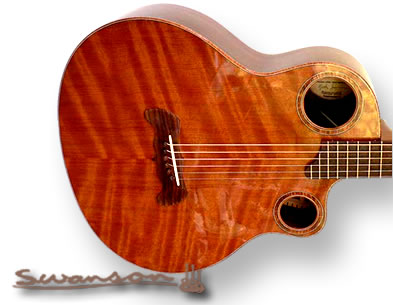
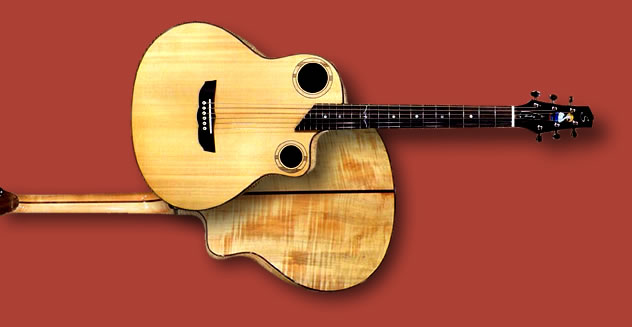
As for sound, I have to agree it does tend to give more emphasis to the bass, but I find it's in a very appealing way. The upper sound hole tends to make the lower registers clearer while also giving them more power. A great win/win.
My favorite ABG is the Thunderchief by Tacoma which really shines, but also in a standard AG if the sound hole is made larger to balance out the bass tendency, you still have that clear bass attenuation and a larger sound in general. And they'e quite attractive in Mark's guitars!
Since the idea of freeing up the soundboard under the fretboard came up in the adjustable neck thread I have been thinking about this.
If you were to start the design process from scratch you might make quite a different SS guitar from what we have today. Having a hole in the middle lends itself to the creation of the X brace because there is this bloody great hole to get around. But the hole placement in a SS is a hand me down from classicals.
That strong structure must surely separate the soundboard into 4 bits with the largest and most effective under the bridge. So I am not surprised that tests show not much happening in the upper bout which has two strong braces separating it from the bridge.
If you don't have a hole there you don't have to use an X brace and you can design different bracing that utilises more of the soundboard.
The way I have been thinking about it is like this. Assume all the bracing is in place for a guitar but we have removed the actual top plates.
With the adoption of the A frame bracing pattern connecting to the neckblock we are effectively building an extension of the neck that connects with X brace and the bridge. If the strings are flat to the neck almost all of the string tension is taken up with compression and it takes very little energy to keep it balanced in that spot. It’s like pulling one of those muscle building spring things down with one arm. Once you get it parallel with your forearm it takes only a little energy to keep it balanced there.
Now with the top back on and the angle of the string increased a bit so you can actually play it, the top is tensed and doing a bit of work to keep the structure down and connected to the side (and provides stability by unifying the braces) but can be built lighter and be more responsive.
With out the hole in the middle you don't need the X and without the X you can just connect with a brace structure from the neck straight to the bridge even more efficiently I would think.
But that’s just what I think.
Dom
If you were to start the design process from scratch you might make quite a different SS guitar from what we have today. Having a hole in the middle lends itself to the creation of the X brace because there is this bloody great hole to get around. But the hole placement in a SS is a hand me down from classicals.
That strong structure must surely separate the soundboard into 4 bits with the largest and most effective under the bridge. So I am not surprised that tests show not much happening in the upper bout which has two strong braces separating it from the bridge.
If you don't have a hole there you don't have to use an X brace and you can design different bracing that utilises more of the soundboard.
The way I have been thinking about it is like this. Assume all the bracing is in place for a guitar but we have removed the actual top plates.
With the adoption of the A frame bracing pattern connecting to the neckblock we are effectively building an extension of the neck that connects with X brace and the bridge. If the strings are flat to the neck almost all of the string tension is taken up with compression and it takes very little energy to keep it balanced in that spot. It’s like pulling one of those muscle building spring things down with one arm. Once you get it parallel with your forearm it takes only a little energy to keep it balanced there.
Now with the top back on and the angle of the string increased a bit so you can actually play it, the top is tensed and doing a bit of work to keep the structure down and connected to the side (and provides stability by unifying the braces) but can be built lighter and be more responsive.
With out the hole in the middle you don't need the X and without the X you can just connect with a brace structure from the neck straight to the bridge even more efficiently I would think.
But that’s just what I think.
Dom
You can bomb the world to pieces,
but you can't bomb the world to peace!
but you can't bomb the world to peace!
- Dennis Leahy
- Blackwood
- Posts: 872
- Joined: Wed Oct 10, 2007 12:32 am
- Location: Duluth, MN, US
- Contact:
As I mentioned, I made a set of photos of my attempt at Chladni testing, using purple sand from a hobby store, and repeatedly plucking the strings of the guitar. The back of the guitar was laying on a towel on a cardboard box, with the neck propped up to make the top level. I don't have a signal generator, so I know the patterns I got were amateurish at best. But, if you care to see them, have a look on the Luthierforum Acoustic Guitar Bracing and Top Dimensions thread (my photos start at post # 101. The odd star shaped nodes you see are because of using a radial bracing pattern:

Note that like Dom said, "With out the hole in the middle you don't need the X", I designed purposely eliminating the X, and felt that I had the freedom to move the soundhole anywhere.
Adjustable necks leads to soundhole placement, and soundhole placement leads to bracing. Sorry, Craig, if this strays too far off topic.
Dennis

Note that like Dom said, "With out the hole in the middle you don't need the X", I designed purposely eliminating the X, and felt that I had the freedom to move the soundhole anywhere.
Adjustable necks leads to soundhole placement, and soundhole placement leads to bracing. Sorry, Craig, if this strays too far off topic.
Dennis
Another damn Yank!
- Dave White
- Blackwood
- Posts: 452
- Joined: Mon Nov 12, 2007 3:10 am
- Location: Hughenden Valley, England
- Contact:
- Dennis Leahy
- Blackwood
- Posts: 872
- Joined: Wed Oct 10, 2007 12:32 am
- Location: Duluth, MN, US
- Contact:
I thought these pics interesting.
First of all , this is Tom Bills ( thanks Dave)
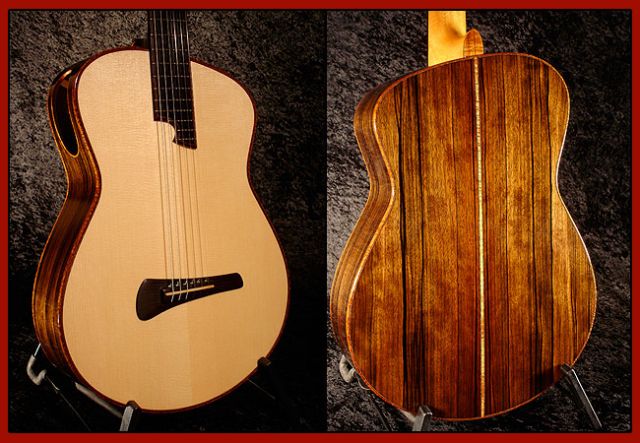
Tom Bills again :
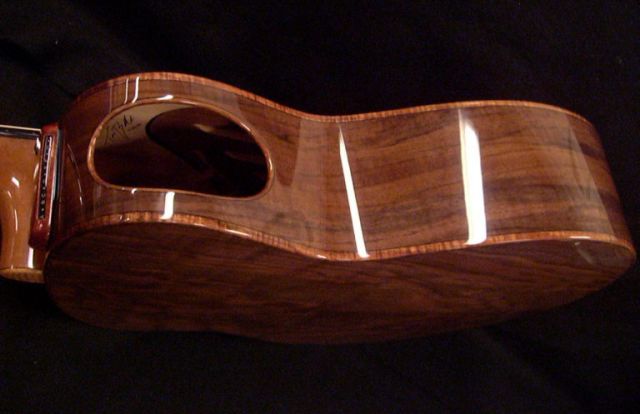
Fred Carlson :
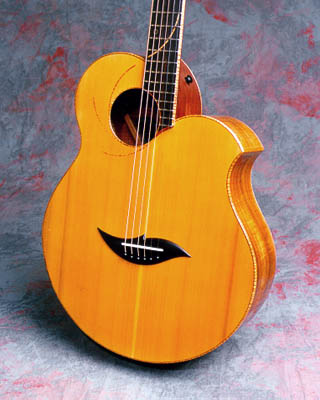
Matsuda :
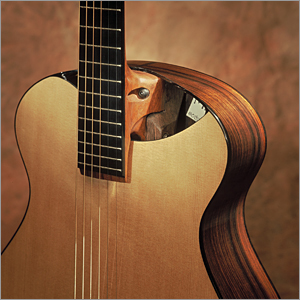
Matsuda again :
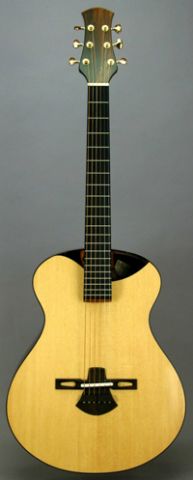
Harry Fleishman :
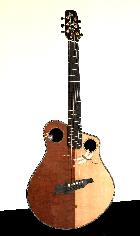
First of all , this is Tom Bills ( thanks Dave)

Tom Bills again :

Fred Carlson :

Matsuda :

Matsuda again :

Harry Fleishman :

Last edited by Craig on Tue Apr 22, 2008 10:50 am, edited 1 time in total.
Some what but it's not as easy as one might think. Increase the size of the sound hole(s) and generally you will increase the bass but at the "possible" expense of the trebles and the guitar is often less punchy too.gratay wrote:I'm just thinking out aloud here but,..
Couldn't you get the desired bass and treble response by altering the diameter of the sound hole no matter where it is situated?
Now since there is an optimum size for a sound hole for a specific body size AND the rest of a specific guitar's "system" i.e. the top, back, woods, used, how it's braced, strings used, etc. it's possible that a design has a sound hole that is not large enough in the first place - or vice versa.
I have played Mark Swanson's Fat Boys and they are incredible guitars and a guitar that I would not mind owning for myself.
- graham mcdonald
- Blackwood
- Posts: 473
- Joined: Thu Oct 25, 2007 11:57 am
- Location: Canberra
- Contact:
Back to resonances again. The air resonance (the one you get when you hum into the soundhole) has to relate to the soundboard resonances. Changing the soundhole size by itself might shift the air resonance, but if that is not matched to what the soundboard is doing the instrument is not going to work as well as it might. You have to know what the soundboard is doing and at what frequencies. This is fairly simply done by driving the soundboard with something like a speaker coupled to the bridge and a sweep frequency generator and recording the sound coming off the instrument with a microphone into a computer and putting the frequency sweep up on the screen. At the air resonance and at the frequencies that the soundboard shows the patterns in the holographic photos there are big peak sin the output. The idea is that if you measure those peaks on a "good" instrument and then can reproduce them in another, it should sound just as "good". The sound board resonances in a finished instrument are related to the chladni patterns on a free plate (unattached) soundboard, but I don't think anyone has worked out exactly how they relate, especially when you add in the enclosed volume of the body and the fact that the back has its own modes of vibration. Graham Caldersmith's articles in American Lutherie over the years are a great start in getting some understanding of this.
All these things are useful tools, but they do require spending a fair bit of time and doing them with a succession of instruments to really get much value out of it. There are lots of possibilities with moving the soundhole(s) and changing the effective area of the soundboard, but a guitar or any other stringed instrument is a system, and changing one thing will usually effect something else or several other aspects as well.
Good fun trying though
This a frequency sweep of a 10 string mandocello/bouzouki that a friend did and sent to me as an example. the 92Hz peak will be the air resonance, the others will correspond to those in the holographic pics (if not at the same frequencies)
cheers
graham
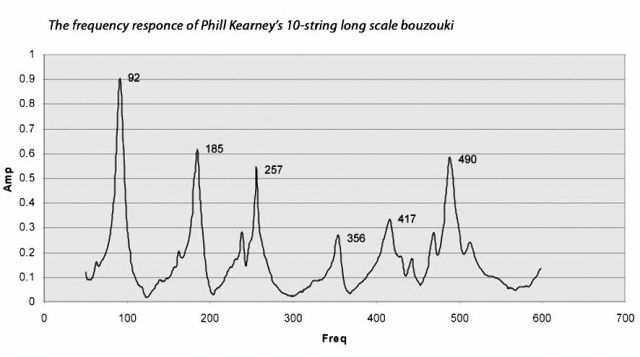
All these things are useful tools, but they do require spending a fair bit of time and doing them with a succession of instruments to really get much value out of it. There are lots of possibilities with moving the soundhole(s) and changing the effective area of the soundboard, but a guitar or any other stringed instrument is a system, and changing one thing will usually effect something else or several other aspects as well.
Good fun trying though
This a frequency sweep of a 10 string mandocello/bouzouki that a friend did and sent to me as an example. the 92Hz peak will be the air resonance, the others will correspond to those in the holographic pics (if not at the same frequencies)
cheers
graham

Graham McDonald
http://www.mcdonaldstrings.com
http://www.mcdonaldstrings.com
G'day Grant ,
Making the soundhole bigger raises the pitch of the bodys frequency. Whether that allows more treble to dominate is another thing , and is something I am hoping other builders can comment on. ????
Jack , thanks for your thoughts . To me , they make good sense .
I found those holograms most interesting Graham. Many thanks . Seems there are two trains of thought regarding the activity of the upper bout . On the one hand there is the Smallman approach where the upper bout is largely ignored as a sound producing area and used mainly as an area to support the neck only . Conversley , others are trying to utilize every square inch of soundboard they can muster. I'm thinking that the bracing plan must have a lot to do with how the upper bout is going to behave. One would need holograms of each builders efforts to decide whether in fact the upper bout should indeed be largley ignored ,or utilized to it's maximim. As both Jack and yourself state , ,,,, Time !
As a long time Piano Tuner/ Tech. I can't help but think of the Concert Grand verses Baby grand analogy. The bigger sound boards are mind blowing in their performance as opossed to the baby's appearing whimps in comparison. True , their string lengths are different too, which has to contribute to that difference somewhat.
Jeff , as you can see by the above guitar pics , there are some who don't have soundholes in the soundboard at all. Makes good sense ,if I'm to believe the grand piano analogy . The soundbox contribution is pushed elsewhere than in front though , and I wonder whether this has some sort of affect from a listeners point of view.
Dennis ,,,,, your just plain mad ! Seriously though , I for one appreciate you alternate efforts . Don't worry about bringing bracing into the thread . As you say it's all relevant. Lets just see where the thread takes us with no constraints.
Seriously though , I for one appreciate you alternate efforts . Don't worry about bringing bracing into the thread . As you say it's all relevant. Lets just see where the thread takes us with no constraints.
Thanks for those pics of Mark Swansons guitar Billy . I agree that it doesn't at all appear ugly . As Dennis said , we aren't that used to looking at guitars with soundholes placed elsewhere than the traditional spot. The more I look at others ,the more I seem to be nonshocked at their appearance.
Sounds to me like you're becoming an A Frame fan Dom.. Good to get your thoughts mate , and appreciated.
Cheers ,Craig
Making the soundhole bigger raises the pitch of the bodys frequency. Whether that allows more treble to dominate is another thing , and is something I am hoping other builders can comment on. ????
Jack , thanks for your thoughts . To me , they make good sense .
I found those holograms most interesting Graham. Many thanks . Seems there are two trains of thought regarding the activity of the upper bout . On the one hand there is the Smallman approach where the upper bout is largely ignored as a sound producing area and used mainly as an area to support the neck only . Conversley , others are trying to utilize every square inch of soundboard they can muster. I'm thinking that the bracing plan must have a lot to do with how the upper bout is going to behave. One would need holograms of each builders efforts to decide whether in fact the upper bout should indeed be largley ignored ,or utilized to it's maximim. As both Jack and yourself state , ,,,, Time !
As a long time Piano Tuner/ Tech. I can't help but think of the Concert Grand verses Baby grand analogy. The bigger sound boards are mind blowing in their performance as opossed to the baby's appearing whimps in comparison. True , their string lengths are different too, which has to contribute to that difference somewhat.
Jeff , as you can see by the above guitar pics , there are some who don't have soundholes in the soundboard at all. Makes good sense ,if I'm to believe the grand piano analogy . The soundbox contribution is pushed elsewhere than in front though , and I wonder whether this has some sort of affect from a listeners point of view.
Dennis ,,,,, your just plain mad !
Thanks for those pics of Mark Swansons guitar Billy . I agree that it doesn't at all appear ugly . As Dennis said , we aren't that used to looking at guitars with soundholes placed elsewhere than the traditional spot. The more I look at others ,the more I seem to be nonshocked at their appearance.
Sounds to me like you're becoming an A Frame fan Dom.. Good to get your thoughts mate , and appreciated.
Cheers ,Craig
- graham mcdonald
- Blackwood
- Posts: 473
- Joined: Thu Oct 25, 2007 11:57 am
- Location: Canberra
- Contact:
Try this :
Find a bottle you can "play the jug on " i.e. blow across the lip. Whilst remembering the pitch ,shove a tight fitting tube in the neck of the bottle, thereby narrowing the opening. You can use whatever fits . Hello Mr. Bassman ! you'll see how little it takes to change pitch too !
you'll see how little it takes to change pitch too !
The smaller hole slows things down
Find a bottle you can "play the jug on " i.e. blow across the lip. Whilst remembering the pitch ,shove a tight fitting tube in the neck of the bottle, thereby narrowing the opening. You can use whatever fits . Hello Mr. Bassman !
The smaller hole slows things down
-
Rick Turner
- Blackwood
- Posts: 310
- Joined: Sun Jan 13, 2008 10:22 am
- Location: Santa Cruz, Ca.
- Contact:
This is basic Helmholz here. Try making the sound hole of any guitar smaller by sliding a piece of stiff cardboard over it bit by bit. You'll hear the effect of the Helmholz resonance going lower as you block more of the hole. Of course there's a point where you lose so much air coupling that you are now only hearing direct radiation from the top which will fool you into thinking the frequency is going up. And there is indeed a point where it does as you're getting no coupling with the inner air chamber at all...
Rick Turner
Guitar Maker, Experimenter, Diviner
www.renaissanceguitars.com
www.d-tar.com
Guitar Maker, Experimenter, Diviner
www.renaissanceguitars.com
www.d-tar.com
- Dave White
- Blackwood
- Posts: 452
- Joined: Mon Nov 12, 2007 3:10 am
- Location: Hughenden Valley, England
- Contact:
Craig,Craig L wrote: I found those holograms most interesting Graham. Many thanks . Seems there are two trains of thought regarding the activity of the upper bout . On the one hand there is the Smallman approach where the upper bout is largely ignored as a sound producing area and used mainly as an area to support the neck only . Conversley , others are trying to utilize every square inch of soundboard they can muster. I'm thinking that the bracing plan must have a lot to do with how the upper bout is going to behave. One would need holograms of each builders efforts to decide whether in fact the upper bout should indeed be largley ignored ,or utilized to it's maximim. As both Jack and yourself state , ,,,, Time !
You don't need no stinkin' holograms
As to soundhole size - big ones can certainly make a guitar loud. I think Mario Proulx is of the same view. I use between 106-110mm diameter soundholes on most of my instruments (94mm on my copies of my old Concert sized guitar) and this works on small and big instruments. You can get some of the "bass" back by moving the soundhole further up towards the neck.
Big BUT (yes I probably have one
Dave White
[url=http://www.defaoiteguitars.com]De Faoite Stringed Instruments[/url]
[url=http://www.defaoiteguitars.com]De Faoite Stringed Instruments[/url]
- Dave White
- Blackwood
- Posts: 452
- Joined: Mon Nov 12, 2007 3:10 am
- Location: Hughenden Valley, England
- Contact:
Who is online
Users browsing this forum: No registered users and 79 guests